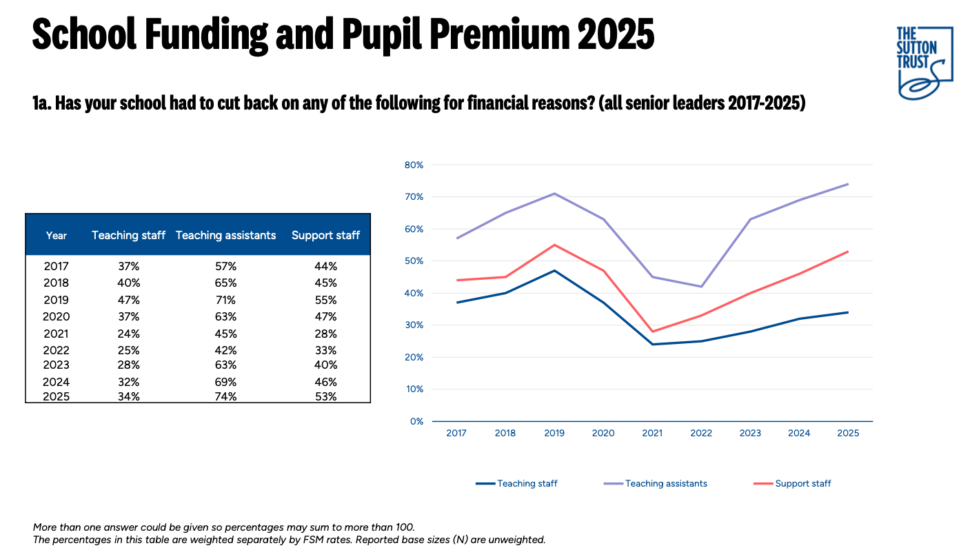A surge in schools making cuts shows they are “rapidly heading towards the brink” and is threatening the government’s promise to break down barriers to opportunity in education, a leading charity has said.
More schools are cutting teaching staff, support staff and teaching assistants than any time since 2020, a survey for the Sutton Trust has found.
Nearly half of secondary school leaders polled said they are now using pupil premium cash to plug gaps – the highest since the annual poll started in 2017, and 13 percentage points up on last year.
“State schools are overwhelmed with financial pressures, and many are rapidly heading towards breaking point,” said Nick Harrison, CEO of the Sutton Trust. “If action isn’t taken, we’ll be failing the next generation.”
‘Further cuts’
Schools Week revealed last month the funding storm hitting schools, with many looking at further cuts to afford unfunded teacher pay rises, increasing national insurance contributions and rising costs elsewhere.
“School funding must be protected in the forthcoming spending review if the government is serious about breaking down barriers to opportunity,” Harrison added.
“Urgent action is needed, starting with carefully targeted measures to rebalance funding towards schools in the most deprived areas.”
More than half of secondary school senior leaders surveyed in March reported making cuts in teaching staff, up from 38 per cent last year. Half reported cuts to TAs, up from 41 per cent.
Fifty-five per cent of secondary heads reported cutting support staff, the highest figure since 2020. Meanwhile, cuts at primary schools are their highest since polling began in 2017.
A total of 1,208 teachers responded to the National Foundation for Educational Research’s (NFER) Teacher Voice Omnibus Survey.

‘Avoid grinding austerity’
The Sutton Trust said the findings show Labour risks failing one of its own five “missions” – to break down barriers to opportunity for every child.
“The government was elected on promises to improve schools and to increase the life chances of children brought up in poverty – holding down education funding runs counter to both goals,” said Daniel Kebede, general secretary of the NEU.
“We need a radical change of direction with the June spending review to avoid grinding austerity over the rest of this parliament.”
Another key Labour pledge is to update the national curriculum, with a review ongoing. But a third of secondary school leaders said they will reduce the choices they offer at GCSE because of funding constraints, up from 29 per cent last year.
Pepe Di’Iasio, general secretary of the Association of School and College Leaders, said the government is set to make the situation “even worse” by implementing the 2025-26 teachers’ pay award without necessary funding.
The government’s “suggestion that this can be funded by further ‘efficiencies’ is for the birds. All possible ‘efficiencies’ were exhausted long ago and it is now just a synonym for cuts,” he added.
“No school leader wants to be in the position of losing teachers or support staff, but the financial situation facing schools and colleges has seldom been as grim as it is right now.
The Sutton Trust is now calling for a new national strategy to close the attainment gap, including restoring the pupil premium to its full value. The Sutton Trust said it has fallen by 20 per cent in real-terms since 2014-15.
A DfE spokesperson said: “Despite our tough fiscal inheritance, including a £22 billion black hole in the public finances, this government has protected key education priorities through our Plan for Change.
“In 2025-26, we are putting a further £3.2bn into schools’ budgets and increasing pupil premium to over £3 billion to provide additional support for those children that need it most.”















Your thoughts